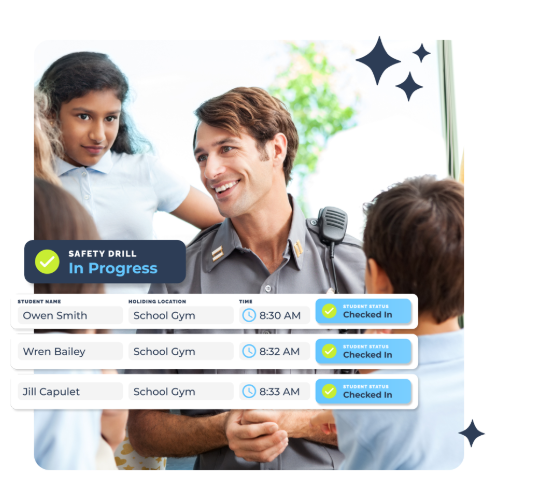
School safety has always been a critical concern, but in today’s unpredictable world, it's more important than ever. From natural disasters and weather warnings to security threats and health emergencies, schools need fast, effective ways to communicate with staff, students, and parents.
That’s where an emergency alert system for schools comes in. These systems provide real-time, automated alerts to keep everyone informed, prepared, and protected. When paired with School Reunification Software, they form a powerful safety infrastructure that ensures students are not only alerted during a crisis but also safely reunited with their families afterward.
In this guide, we’ll explore how these systems work, their key features, and why every school should implement one as part of a comprehensive emergency preparedness plan.
What Is an Emergency Alert System for Schools?
An emergency alert system for schools is a digital communication tool designed to deliver immediate, reliable notifications during crises. These alerts can be sent via multiple channels, such as text, email, push notifications, loudspeakers, digital signage, and even classroom computers.
The goal is to ensure that every stakeholder—students, teachers, staff, and parents—receives accurate and timely information when seconds count.
Emergency alerts can be used in a wide range of situations, including:
Lockdowns and active shooter situations
Evacuations due to fire or gas leaks
Severe weather warnings (tornado, hurricane, flood)
Medical emergencies
Hazardous material incidents
Health-related closures (pandemics, outbreaks)
How Emergency Alert Systems Work
Here’s a step-by-step breakdown of how a school emergency alert system operates in a real-world scenario:
1. Incident Detection or Reporting
The emergency begins—this could be a security breach, fire alarm, or severe weather alert. The threat might be identified by a staff member, surveillance system, or automatically detected through integration with other emergency tools.
2. Activation of the System
An authorized user (such as a principal, safety officer, or superintendent) activates the emergency alert system. Most platforms offer mobile apps or web-based dashboards to quickly initiate protocols with just a few clicks or taps.
Many systems also support pre-configured scenarios, allowing for rapid deployment of appropriate messaging and actions for specific emergencies.
3. Multichannel Alert Dissemination
Once activated, the system pushes out alerts across multiple channels:
Text messages and email to parents, staff, and students
PA announcements for on-campus communication
Push notifications via mobile apps
Pop-ups on school computers
Classroom screen takeovers
Digital signage updates
This ensures redundancy—if one channel fails, others still deliver the critical message.
4. Instructions and Status Updates
The system sends detailed instructions on what actions to take:
Shelter in place
Evacuate to a specific location
Lock classroom doors
Avoid certain areas
As the situation evolves, administrators can continue to send updates, ensuring everyone remains informed in real time.
5. Integration with School Reunification Software
After the immediate threat has passed, the focus shifts to reuniting students with their guardians. School Reunification Software steps in to manage this process.
Students are checked out using secure methods (QR codes, ID verification), and parents are notified of pickup locations and procedures. The system logs every handoff to ensure no student is left behind or released to the wrong person.
Key Features of an Effective School Emergency Alert System
To ensure maximum effectiveness, a good emergency alert system for schools should include:
✔ Multichannel Messaging
Deliver alerts through SMS, email, phone calls, push notifications, and intercoms.
✔ Pre-set Emergency Scenarios
Save time during crises with ready-to-deploy templates for common emergencies.
✔ Location-Based Alerts
Send alerts to specific areas or buildings rather than the entire campus when needed.
✔ Two-Way Communication
Allow staff and parents to respond or report updates through the system.
✔ Integration with Reunification Software
Streamline post-emergency student check-outs and guardianship verifications.
✔ Real-Time Monitoring
Track who has received the message and who hasn’t to follow up accordingly.
✔ Cloud-Based Access
Enable remote access so administrators can trigger alerts off-campus if necessary.
Benefits of Using an Emergency Alert System in Schools
🔒 Improved Safety and Response Times
The faster you can communicate in a crisis, the better the outcome. An emergency alert system speeds up response times and helps everyone act with clarity.
👨👩👧👦 Increased Parental Confidence
Parents feel reassured knowing they’ll be instantly informed during emergencies and that School Reunification Software ensures a smooth, safe pickup.
🧠 Reduced Panic and Confusion
Clear, consistent communication prevents misinformation and helps manage fear during chaotic situations.
📊 Compliance and Reporting
Many systems offer post-event analytics, message logs, and user activity reports to aid with legal compliance and incident reviews.
Emergency Alerts + School Reunification: A Critical Combo
A school’s emergency plan is only as strong as its reunification process. After a lockdown, fire drill, or evacuation, ensuring every student gets home safely is a logistical and emotional challenge.
School Reunification Software works alongside alert systems to:
Track student locations during and after the emergency
Authenticate guardians with digital IDs
Log pickup times and locations
Prevent unauthorized releases
Together, these tools provide a 360-degree solution—from crisis notification to family reunification.
Real-World Use Case
Imagine a scenario where a tornado warning is issued mid-day. The principal activates the emergency alert system with a predefined “Severe Weather” template.
Students are immediately directed to safe zones through intercom and mobile alerts.
Parents receive texts informing them of the school’s lockdown procedure and reassuring them their children are safe.
After the storm passes, School Reunification Software is activated. Parents are given precise instructions on where to pick up their children.
Each student is checked out and verified digitally, with logs automatically generated for compliance and review.
What would have been a chaotic and high-risk situation becomes a coordinated, professional response.
Frequently Asked Questions (FAQ)
Q1: What is an emergency alert system for schools?
A: It’s a digital platform that sends real-time alerts during crises to students, staff, and parents. It supports multichannel messaging and helps schools manage emergency communication quickly and effectively.
Q2: What is School Reunification Software?
A: It’s a tool used during and after school emergencies to safely reunite students with their guardians. It verifies identities, tracks checkouts, and helps maintain order during high-stress situations.
Q3: Can the alert system be used for non-emergencies?
A: Yes. Many systems also support general announcements, such as weather delays, early dismissals, or transport changes.
Q4: How do these systems ensure alerts are received?
A: They use multiple communication channels and provide delivery receipts and read confirmations to ensure critical messages reach their recipients.
Q5: Is it difficult to implement these systems?
A: Not at all. Most platforms offer user-friendly interfaces, onboarding support, and training for staff. Many integrate with existing school information systems (SIS) and directories.
Q6: Are these systems secure?
A: Yes. Leading solutions use encryption, secure logins, role-based access, and audit trails to protect sensitive information.
Q7: Can parents access the emergency system?
A: Parents don’t initiate alerts, but they receive messages and updates, and interact with the system during reunification processes through apps or secure portals.
Final Thoughts
In a world where emergencies can strike at any moment, having an effective emergency alert system for schools is not just a convenience—it’s a necessity. Paired with School Reunification Software, it becomes a robust, full-cycle safety net that supports your staff, reassures parents, and most importantly, protects students.
Don’t wait for a crisis to reveal the gaps in your communication strategy. Equip your school with the tools it needs to act swiftly, inform accurately, and reunite safely.









Write a comment ...